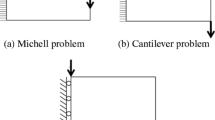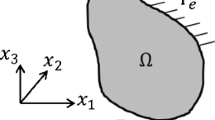Abstract
A nonparametric gradient-less shape optimization approach for finite element stress minimization problems is presented. The shape optimization algorithm is based on optimality criteria, which leads to a robust and fast convergence independent of the number of design variables. Sensitivity information of the objective function and constraints are not required, which results in superior performance and offers the possibility to solve the structural analysis task using fast and reliable industry standard finite element solvers such as ABAQUS, ANSYS, I-DEAS, MARC, NASTRAN or PERMAS. The approach has been successfully extended to complex nonlinear problems including material, boundary and geometric nonlinear behavior. The nonparametric geometry representation creates a complete design space for the optimization problem, which includes all possible solutions for the finite element discretization. The approach is available within the optimization system TOSCA and has been used successfully for real-world optimization problems in industry for several years. The approach is compared to other approaches and the benefits and restrictions are highlighted. Several academic and real-world examples are presented.
Similar content being viewed by others
References
Bakhtiary-96 Bakhtiary N and other (1996) A new approach for sizing, shape and topology optimization. SAE International Congress and Exposition, Detroit/Michigan
Banichuk-95 Banichuk NV, Barthold F-J, Falk A, Stein E (1995) Mesh refinement for shape optimization. Struct Optim 9:46–51
Barthelemy-93 Barthelemy J-FM, Haftka RT (1993) Approximation concepts for optimum structural design—a review. Struct Optim 5:129–144
Baud-34 Baud RV (1934) Fillet profiles for constant stress. Prod Eng 5(4):133–134
Belegundu-88 Belegundu AD, Rajan SD (1988) A shape optimization approach based on natural design variables and shape functions. Comput Methods Appl Mech Eng 66:87–106
Bennett-85 Bennett JA, Botkin ME (1985) Structural shape optimization with geometric description and adaptive mesh generation. AIAA J 23:458–464
Bletzinger-90 Bletzinger K-U (1990) Formoptimierung von Flächentragwerken. Institut für Baustatik, University of Stuttgart, Dissertation
Bletzinger-91 Bletzinger K-U, Kimmich S, Ramm E (1991) Efficient modeling in shape optimal design. Comut Syst Eng 2:483–495
Braibant-84 Braibant V, Fleury C (1984) Shape optimal design using B-splines. Comput Methods Appl Mech Eng 44:247–267
Chen-93 Chen JL, Tsai WC (1993) Shape optimzation using simulated biological growth approaches. AIAA J 31:2143–2147
Cheng-93-2 Cheng G, Olhoff N (1993) Rigid body motion test against error in semi-analytical sensitivity analysis. Comput Struct 46:515–527
Cherepanov-74 Cherepanov GP (1974) Inverse problems of the plane theory of elasticity. J Appl Math Mech 39(6):1082–1092
Cohn-94 Cohn MZ (1994) Theory and practice of structural optimization. Struct Optim 1994:20–31
Ding-86 Ding Y (1986) Shape optimization of structures: a literature survey. Comput Struct 24:985–1004
Falk-99 Falk A, Barthold F-J, Stein E (1999) A hierarchical design concept for shape optimization based on the interaction of CAGD and FEM. Struct Optim 18:12–23
Fancello-95 Fancello EA, Haslinger J, Feijóo RA (1995) Numerical comparison between two cost functions in contact shape optimization. Struct Optim 9:57–68
Gellatly-76 Gellatly RA, Dupree DM (1976) Examples of computer-aided optimal design of structures. 10th IABSE Congress, 77–105, Tokyo
Goldberg-89 Goldberg DE (1989) Genetic algorithms in search, optimization and machine learning. Addison–Wesley, Boston
Haftka-86 Haftka RT, Grandhi RV (1986) Structural shape optimization—a survey. Comput Methods Appl Mech Eng 57:517–522
Iancu-90 Iancu G (1990) Spannungskonzentrationsminimierung dreidimensionaler elastischer Kontinua mit der FEM. University of Karlsruhe, Dissertation
Imam-82 Imam MH (1982) Three-dimensional shape optimization. Int J Numer Methods Eng 18:661–673
Kikuchi-86 Kikuchi N, Chung KY, Torigaki T, Taylor JE (1986) Adaptive finite element methods for shape optimization of linearly elastic structures. Comput Methods Appl Mech Eng 57:67–89
Kirsch-93 Kirsch U (1993) Structural optimization: fundamentals and applications. Springer, Berlin Heidelberg New York
Mattheck-90 Mattheck C, Burkardt S (1990) A new method of structural shape optimization based on biological growth. Int J Fatigue 12:185–190
Meske-02 Meske R, Mulfinger F, Warmuth O (2002) Topology and shape optimization of components and systems with contact boundary conditions. In: Modellieren von Baugruppen und Verbindungen für FE-Berechnungen, Wiesbaden, April 2002, NAFEMS
Neuber-57 Neuber H (1957) Kerbspannungslehre, Grundlagen für genaue Festigkeitsberechnung. 2nd edn, Springer, Berlin Heidelberg New York
Olhoff-93 Olhoff N, Rasmussen J, Lund E (1993) Method of exact numerical differentiation for error elimination in finite element based semi-analytical shape sensitivity analysis. Mech Struct Mach 21:1–66
Paczelt-94 Páczelt L, Szabó T (1994) Optimal shape design for contact problems. Struct Optim 7:66–75
Pedersen-00 Pedersen P (2000) On optimal shape in materials and structures. Struct Multidisc Optim 19:169–182
Rechenberg-89 Rechenberg I (1989) Evolution strategy: nature’s way of optimization. In: Bergmann H (ed) Optimization: methods and applications, possibilities and limitations. Springer, Berlin Heidelberg New York, pp. 106–126
Sauter-91 Sauter J (1991) CAOS oder die Suche nach der optimalen Bauteilform durch eine effiziente Gestaltoptimierungsstrategie. XX. Internationaler Finite Elemente Kongress, Baden-Baden, November 1991
Schittkowski-94 Schittkowski K, Zillober C, Zotemantel R (1994) Numerical comparison on nonlinear programming algorithms for structural optimization. Struct Optim 7:1–28
Schleupen-00 Schleupen A, Maute K, Ramm E (2000) Adaptive FE-procedures in shape optimization. Struct Multidisc Optim 19:282–302
Schnack-77 Schnack E (1977) Ein Iterationsverfahren zur Optimierung von Spannungskonzentrationen. University of Kaiserslautern, Habilitation
Schnack-79 Schnack E (1979) An optimization procedure for stress concentrations by the finite element technique. Int J Numer Math Eng 14:115–124
Schnack-80 Schnack E (1980) Optimierung von Spannungskonzentrationen bei Viellastbeanspruchung. ZAMM 60:151–152
Schnack-86 Schnack E, Spörl U (1986) A mechanical dynamic programming algorithm for structure optimization. Int J Numer Math Eng 23:1985–2004
Schnack-88 Schnack E, Spörl U, Iancu G (1988) Gradientless shape optimization with FEM. VDI Forschungsheft, 647
Spoerl-85 Spörl U (1985) Spannungsoptimale Auslegung elastischer Strukturen. University of Karlsruhe, Dissertation
Vanderplaats-84 Vanderplaats G (1984) Numerical optimization techniques for engineering design. McGraw–Hill, New York
Woon-01 Woon SY, Querin OM, Steven GP (2001) Structural application of a shape optimization method based on a genetic algorithm. Struct Multidisc Optim 22:57–64
Zhang-92 Zhang S, Belegundu AD (1992) A systematic approach for generating velocity fields in shape optimization. Struct Optim 5:84–94
Zhang-95 Zhang W-H, Beckers P, Fleury C (1995) A unified parametric design approach to structural shape optimization. Int J Numer Methods Eng 38:2283–2292
Zienkiewicz-73 Zienkiewicz OC, Campbell JS (1973) Shape optimization and sequential linear programming. In: Gallagher RH, Zienkiewicz OC (eds) Optimum structural design: theory and applications. Wiley, London, pp. 109–126
Author information
Authors and Affiliations
Corresponding author
Rights and permissions
About this article
Cite this article
Meske, R., Sauter, J. & Schnack, E. Nonparametric gradient-less shape optimization for real-world applications. Struct Multidisc Optim 30, 201–218 (2005). https://doi.org/10.1007/s00158-005-0518-0
Received:
Published:
Issue Date:
DOI: https://doi.org/10.1007/s00158-005-0518-0




